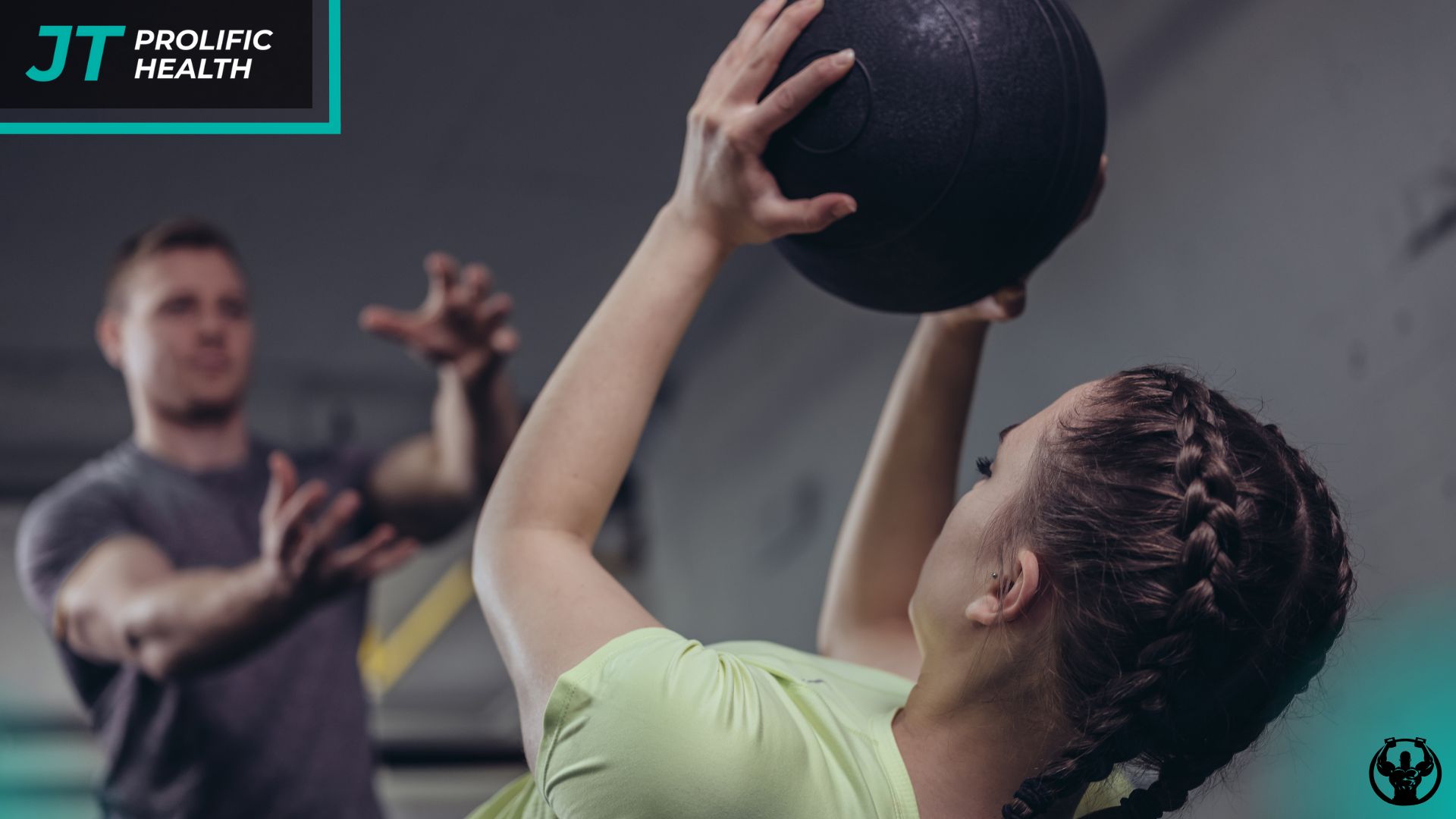Did you know that strength training reduces injury risk by 23% in adults, yet only 30% of women prioritize it? At Prolific Health, we’ve seen firsthand how personalized adjustments empower clients across Richmond and Vancouver to achieve sustainable results. Your body’s needs change with life stages, schedules, and even hormone fluctuations—so why should your routine stay rigid?
Traditional approaches often ignore these realities. Maybe you’ve felt pressured to follow generic plans that don’t match your energy levels or equipment access. Our clients thrive by focusing on what works for their lives—not chasing unrealistic standards.
Think about your last session. Were you confident in every movement? True progress happens when exercises align with your current abilities while gently pushing boundaries. Whether using resistance bands at home or weights at the gym, smart tweaks make all the difference.
Key Takeaways
- Personalized adjustments match your unique energy levels and physical capabilities
- Bodies change through different life phases—your routine should adapt accordingly
- Effective plans work with home equipment, gym machines, or outdoor spaces
- Strength training builds resilience for daily tasks and reduces injury risks
- Safe progression builds confidence as you master new skills
Essential women’s workout modifications


What makes an exercise truly effective? It’s not about copying routines but creating smart adjustments that respect your current abilities. At our Canadian studios, we help clients reshape classic movements to fit their unique physical needs while building sustainable strength.
Start by mastering bodyweight versions of squats and rows before adding resistance. This builds proper movement patterns while reducing strain. Three key principles guide safe progression:
- Adjust depth or speed to match energy levels
- Use benches or walls for stability during presses
- Focus on controlled motions rather than heavy weights
Compound movements like deadlifts engage multiple muscle groups efficiently. If balance feels shaky, try staggered stances or reduce the range of motion. Your training should adapt to daily fluctuations—some days call for shorter sets, others allow deeper challenges.
Proper form remains non-negotiable. If an exercise causes joint discomfort, modify the angle or support. Assisted variations using resistance bands let you build foundational strength safely. Remember, progression isn’t linear—honor your body’s signals while gradually expanding capabilities.
Understanding Your Fitness Level


Assessing your starting point is the first step to meaningful progress. At Prolific Health, we guide clients in Richmond and Vancouver through judgment-free evaluations that highlight current capabilities and realistic goals. Research shows starting with three weekly sessions of 20-30 minutes builds sustainable habits while respecting recovery needs.
Identifying Your Baseline
Your baseline isn’t about others—it’s about your unique starting line. Track how long you maintain proper form during squats or planks. Note recovery time between sets and any stiffness that lingers post-session. These markers reveal your true capacity today.
Consider sleep patterns, stress levels, and past injuries. A balanced routine accounts for these variables without shame. Muscle mass naturally declines after thirty, making honest assessments crucial for maintaining strength long-term.
Progression and Adaptation
Growth happens through small, consistent upgrades. Add one rep weekly or extend plank holds by five seconds. Beginners often see rapid improvements in endurance before tackling heavier weights.
Your body adapts best when challenged moderately. Alternate intense days with active recovery like walking or yoga. Track subtle wins—smoother movements, faster bounce-back between circuits—to gauge readiness for new challenges.
Remember: energy fluctuates daily. Some sessions feel effortless; others demand scaled-back versions. Both outcomes are valid steps toward lasting resilience.
Adapting Bodyweight Exercises for Your Body
Your own weight offers endless possibilities when you understand how to adjust positions and pacing. Unlike rigid equipment-based routines, bodyweight exercises let you modify intensity through simple changes in angles or support. This approach builds strength where it matters most—in daily life.


Start with push-ups by positioning hands on a sturdy chair or wall. Elevating your upper body reduces strain while maintaining core engagement. As strength grows, lower the surface height until you master floor variations.
Squats become safer when using a seat behind you for controlled depth. Lightly touch the chair during descent to ensure proper alignment. This method prevents knee strain while building leg power gradually.
Plank progressions begin on knees or against a countertop. Focus on keeping your body in a straight line from shoulders to hips. Shorten hold times initially, increasing duration as stability improves.
Lunge adjustments include reducing step length or holding a wall for balance. Stationary versions let you concentrate on form before attempting dynamic movements. Always prioritize pain-free range of motion over depth.
Your exercise tempo directly impacts difficulty. Slowing down during squats or adding pauses at challenging positions increases muscle activation. These subtle shifts help you progress without needing extra equipment.
Enhancing Workouts with Resistance Training
Resistance training transforms everyday spaces into powerful fitness zones. At Prolific Health, we guide clients to build strength using tools they already own—no bulky machines required. Whether you’re in a condo or a backyard, strategic equipment choices create adaptable routines that grow with you.
Dumbbell Variations
Start with lighter weights to perfect your technique. Household items like water bottles work if you’re new to resistance training. Focus on these adjustments:
- Use single dumbbells for unilateral exercises to address muscle imbalances
- Reduce range of motion during shoulder presses if joints feel strained
- Perform seated bicep curls for better spinal alignment
Choose weights that make the final 2-3 reps challenging but achievable. Most clients begin with 10-15 lb dumbbells for upper body exercises, adjusting based on muscle group strength.
Resistance Band Alternatives
Bands provide dynamic tension that mirrors gym machines. Anchor them to doors or stable furniture for full-body engagement. Key benefits include:
- Adjustable resistance by changing band thickness or grip width
- Lower joint impact during lat pulldowns and chest presses
- Portability for travel-friendly routines
Master foundational movements like rows before increasing intensity. Swap bands for dumbbells weekly to keep muscles adapting—variety drives progress.
Integrating HIIT for Intensity and Benefits
High-intensity interval training reshapes fitness routines by packing results into short, focused bursts. At Prolific Health, we design HIIT programs that align with your energy reserves while protecting joint health. These sessions typically alternate 30-second efforts with 15-second recovery windows, delivering cardio benefits in 15-30 minutes.
Customising Intervals
Begin with achievable work-to-rest ratios to build endurance safely. Try 20 seconds of activity followed by 40 seconds of rest before progressing. Three key strategies maintain effectiveness:
- Adjust effort levels rather than extending duration
- Keep heart rate at 70-85% of maximum during active phases
- Swap high-impact moves for step-ups or incline push-ups
Beginners thrive with two weekly sessions, increasing frequency as stamina improves. Always start with dynamic stretches and finish with controlled breathing exercises.
Maintaining Correct Form
Quality movement prevents injuries during intense intervals. If burpees strain your wrists, perform them on an elevated surface. During squat jumps, land softly with knees aligned over toes. Essential form reminders:
- Engage core muscles throughout each exercise
- Shorten range of motion if form deteriorates
- Use mirrors or video checks for real-time feedback
Track recovery between sets—if breathing normalizes within 90 seconds, you’re pacing effectively. Modify intensity based on daily energy levels to sustain progress without burnout.
Crafting Home Workouts for Busy Lifestyles
Fitness shouldn’t require a commute or specialized gear—your living room holds untapped potential. Our Richmond and Vancouver clients prove effective routines thrive in compact spaces and tight schedules. The key lies in strategic planning that matches your available time and resources.
Minimal Equipment Options
Three versatile tools cover 90% of home training needs: resistance bands, adjustable dumbbells, and a non-slip mat. Pair these with household items like filled water bottles for curls or stair steps for cardio bursts. Full-body sessions take 40-50 minutes, while equipment-free circuits deliver results in 25.
Combine strength and cardio moves to maximize limited windows. Try alternating bodyweight squats with high knees for 20-minute energy boosts. Pause workouts when life interrupts—resume later without sacrificing effectiveness.
Maximising Small Spaces
Your exercise zone needs only armspan clearance plus one step in each direction. Focus on vertical movements like overhead presses and stationary exercises like glute bridges. A sturdy chair becomes your gym—use it for tricep dips, elevated push-ups, or step-ups.
Consistency improves when you eliminate travel time and weather dependencies. Store gear in a basket under the couch for instant access. Short on space? Wall sits and standing core rotations require zero floor area.
Strengthening Lower and Upper Body Balance
True fitness thrives when every movement supports your natural rhythm. Building balanced strength means creating harmony between muscle groups that power daily life – from climbing stairs to lifting laundry baskets. This approach reduces strain while enhancing mobility as you age.
Core and Posture Focus
Your core acts as the bridge between upper and lower body strength. Modern lifestyles often weaken these stabilizer muscles, leading to compromised posture. Functional exercises rebuild this foundation through movements that mirror real-world needs.
Three essential strategies create lasting postural improvements:
- Start squats with chair support to perfect alignment before adding weights
- Alternate push-ups with rows to balance chest and back development
- Hold planks while consciously engaging deep abdominal muscles
Back strengthening becomes crucial when counteracting tech-neck posture. Try bird-dog exercises that simultaneously engage shoulders and glutes. These movements build spinal stability while teaching your body to move as one unit.
Muscle development should serve practical purposes. Focus on exercises that improve your ability to carry groceries or play with kids. Pair strength sessions with dynamic stretches for tight hip flexors – the secret to maintaining upright posture during long workdays.
Personalising Your Routine with Prolific Health and Local Insights
How does your neighborhood influence your fitness journey? At Prolific Health, we analyze Richmond and Vancouver health reports to craft routines that reflect your environment. Our approach blends municipal activity trends with personalized strategies for lasting results.
Innovative Modifications Backed by Local Government Data
Local statistics reveal key patterns affecting your progress. Over 60% of our clients prefer outdoor sessions during drier months but struggle with consistency in rainy seasons. We address this by creating adaptable plans that shift between park circuits and home-based training seamlessly.
Community health surveys highlight common needs like lower back support for desk workers. Our trainers integrate core-strengthening moves into routines while respecting time constraints. Seasonal adjustments ensure you maintain momentum year-round—think beach walks in summer and indoor mobility flows for winter.
Adapting to Your Unique Fitness Level
Your schedule and energy reserves dictate realistic milestones. A nurse working 12-hour shifts requires different recovery strategies than a parent managing school drop-offs. We assess three factors:
- Daily movement patterns (standing vs. sitting)
- Available time blocks for focused sessions
- Progress markers like easier stair climbing
Training evolves as you grow stronger. What began as chair-assisted squats might become weighted lunges within months. Regular check-ins ensure your routine aligns with both physical gains and lifestyle shifts—because health isn’t static.
Connect with Prolific Health for Expert Guidance
Your fitness journey deserves personalized support that evolves with your schedule and goals. Three weekly sessions can reshape how you move through life—whether building strength for weekend hikes or maintaining energy during busy workdays.
Our Locations in Richmond and Vancouver
Find us minutes from Richmond’s Olympic Oval and Vancouver’s seawall. Our trainers design programs using local parks, gym spaces, and home environments. Many clients combine outdoor circuits with studio sessions throughout the week.
Contact Us at 604 818 6123 for More Information
Start with two 45-minute discovery days to map your unique path. We adapt plans for new parents, career professionals, and active retirees—no rigid templates. Let’s create sustainable routines that fit your calendar and community.
We invite women in Richmond and Vancouver to explore tailored strategies. Call today to schedule your first assessment. Your strongest self begins here.




